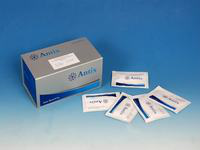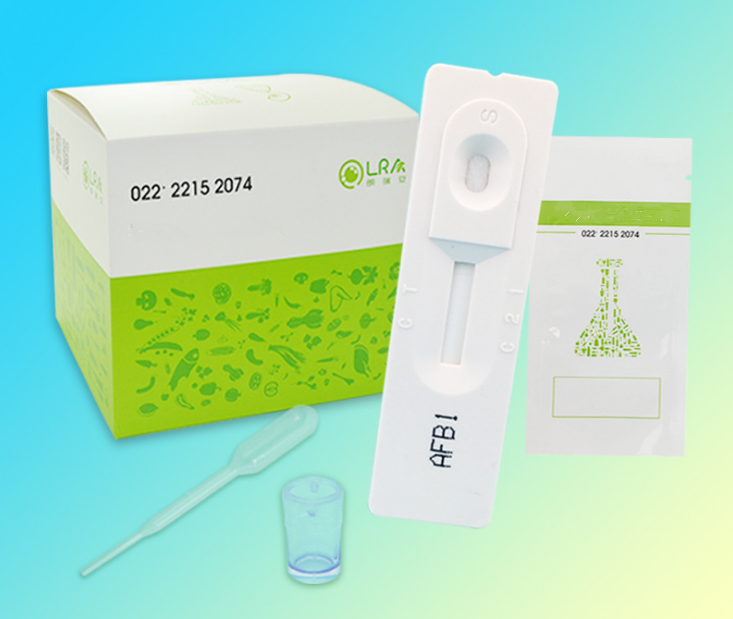
Principle
The AF B1 Rapid Test Strip is based on a competitive colloidal gold immunochromatography technique for rapid screening of grain grains containing AF B1. Add the test solution to the sample well on the test paper card, and combine the AF B1 in the test solution with the gold standard antibody on the gold standard pad to form a complex. If the concentration of AF B1 in the test solution is lower than the sensitivity value, the unbound gold standard antibody flow When it reaches the T region, the AF B1-BSA conjugate immobilized on the membrane combines and gradually aggregates into a visible T line; if the AF B1 concentration is higher than the sensitivity value, the gold standard antibody forms a complex and will no longer be combined with The AF B1-BSA conjugate at the T line combines to form a visible T line. The unfixed composite stream passes through the T zone and is captured by the secondary antibody of the C zone and forms a visible C line. The appearance of the C line indicates that immunochromatography occurs, that is, the test paper is effective.
Sensitivity 5ppb
materials needed:
1. Glassware: beaker, measuring cylinder, dropper, pipette。
2. Small pulverizer, household hair dryer, 4000 rpm centrifuge, balance with a sensitivity of 0.1 g.
3. Ethyl acetate and purified water.

Conservation and stability
Store in a cool and dry place at 4-30 °C. Do not freeze, avoid direct sunlight, and valid for 18 months from the date of production.
Test procedure
1. Take more than 5g of representative grain samples and pulverize them (over 20 mesh sieve), and accurately weigh 2g of uniformly pulverized sample into the centrifuge tube.
2. Accurately add 4 mL of purified water and ethyl acetate to the centrifuge tube, tightly seal the stopper cap, vigorously shake for 5 minutes, and centrifuge at 4000 rpm for 1 minute.
3. Take 2 mL of the supernatant into a small glass with a pipette, and dry the filtrate. Refer to the table and take the corresponding volume of the diluent to reconstitute the bottom of the cup according to the residue limit. This solution is the test solution
Cereal Residue Limit (ppb) 5 10 20 30 40 50 100
Use diluent volume (ml) 0.8 1.6 3.2 4.8 6.4 8 16
4. Remove the test paper, place it on the table after opening, and slowly and accurately add 3 drops of the test solution to the test paper hole with a dropper.
The result was judged at 5.10 minutes, and the result after 12 minutes was invalid.
Explanation of results
Positive: C-line coloration, T-line visible to the naked eye, no matter whether the color depth is negative.
Negative: C-line coloration, T-line does not develop color, and is judged as positive.
Invalid: The C line does not develop color, and the test strip is judged to be invalid regardless of whether the T line is colored or not.
Remarks
This product is a screening reagent. Please use any other method for further confirmation of any suspicious results.
| Main technical parameter | |
| Plate type | 48-/96-well plate or strip |
| Cleaning head | 8/12 wash heads |
| Strip washing | 1-12 wash strip |
| Soaking time | 0-48 hours |
| vibration plate features | vibration plate speed 1-5 grade,time 0-225 seconds |
| Residue volume | ≤1uL |
| Allocation accuracy | ≤±3% at 300uL |
| Washing channels | 1-4 (standard one -channel,2,3 or4- channels are optional) |
| Washing lotion volume | 50UL-2000UL(12-pin) or 50UL-3000UL (8-pin) |
| Interface | USB printer interface ,RS232 |
| power supply | AC220V±22V,50±1Hz |
| size | 445mm×362mm×198mm |
| Working environment | Temperature:5°C-40 °C |
| Humidity:≤85% | |
| Storage environment | Temperature:’-20°C-55 °C |
| Humidity:≤95% | |

近期评论